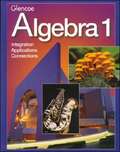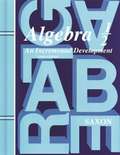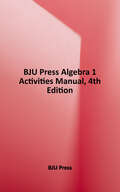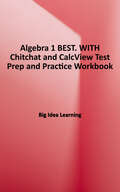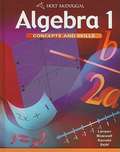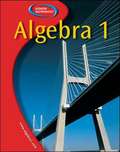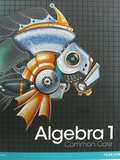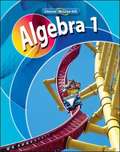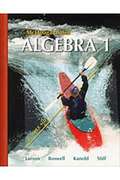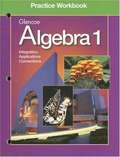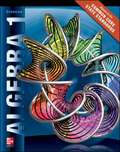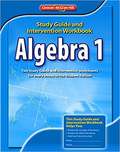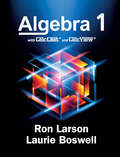- Table View
- List View
Algebra 1
by Collins Publishers Staff Gilbert J. Cuevas Russell J. Foster Gordon Staff Moore-Harris Rath William L. Swart WintersWhy do I need to study algebra? When am I ever going to have to use algebra in the real world? Many people, not just algebra students, wonder why mathematics is important. Algebra 1 is designed to answer those questions through integration, applications, and connections.
Algebra 1: Integration - Applications - Connections
by Mcgraw-Hill StaffGlencoe's Algebra 1 and Algebra 2 balance sound skill and concept development with applications, connections, problem solving, critical thinking, and technology. Whether your students are getting ready for college or the workplace, this program gives them the skills they need for success.
Algebra 1: All-in-One Student Workbook
by The Editors at the Pearson Prentice HallThis book is a complete workbook for students covering all the important topics in Algebra and extensive exercises.
Algebra 1 Activities Manual, 4th Edition
by Bju PressThe Algebra 1 Activities book gives students numerous opportunities for extra practice, enrichment, and collaboration. It also contains 2 STEM projects that can be completed collaboratively over an extended period.
Algebra 1 B.E.S.T. With Chitchat and CalcView Test Prep and Practice Workbook
by Big Idea LearningThis algebra workbook is an essential resource for intermediate students who want to excel in mathematics. It contains a wealth of information, including lessons, practice problems, and exercises that cover a variety of algebraic concepts.
Algebra 1: California Common Core
by Randall I. Charles Basia Hall Dan Kennedy Allan E. Bellman Sadie Chavis Bragg William G. Handlin Stuart J. Murphy Grant WigginsNIMAC-sourced textbook
Algebra 1 - Concepts And Skills (Algebra 1: Concepts And Skills Series)
by Timothy Kanold Ron Larson Laurie Boswell Lee StiffAlgebra 1 (Florida)
by John A. Carter Gilbert J. Cuevas Roger DayA flexible program with the solid content students need Glencoe Algebra 1strengthens student understanding and provides the tools students need to succeed--from the first day your students begin to learn the vocabulary of algebra until the day they take final exams and standardized tests.
Algebra 1 (Glencoe Mathematics)
by Berchie Holliday Gilbert J. Cuevas Beatrice Moore-Harris John A. Carter Daniel Marks Ruth M. Casey Roger Day Linda M. HayekFrom the first day your students begin to learn the vocabulary of algebra until the day they take final exams and standardized tests, these programs strengthen student understanding and provide the tools students need to succeed.
Algebra 1 [Grade 8/9]
by Randall Inners Charles Prentice-Hall IncPearson is proud to offer a NEW Common Core Edition of the same great high school mathematics program that has already been proven effective by an independent research study. The new program fully addresses the Common Core Content Standards and infuses the Standards for Mathematical Practice throughout every lesson.
Algebra 1 (Illinois)
by Ron Larson Laurie Boswell Timothy D Kanold Lee StiffThe content of Algebra 1 is organized around families of functions, with special emphasis on linear and quadratic functions. As you study each family of functions, you will learn to represent them in multiple ways--as verbal descriptions, equations, tables, and graphs. You will also learn to model real-world situations using functions in order to solve problems arising from those situations.
Algebra 1 (Missouri)
by Ron Larson Laurie Boswell Timothy D. Kanold Lee StiffNIMAC-sourced textbook
Algebra 1 Practice Workbook
by Glencoe McGraw-Hill StaffThis Practice Workbook gives you additional practice for the concept exercises in each lesson. The Practice exercises are designed to aid your study of mathematics by reinforcing important mathematical skills needed to succeed in the everyday world. The material is organized by chapter and lesson with one practice worksheet for every lesson in Algebra 1.
Algebra 1 Rescue! Student Book, Chapters 1-6
by Larry Bradsby Tom Botkin Richard Bradsby Gene Collins George Dinwiddie Dean Larsen Hope Law Jane Walker Art WilsonAlgebra 1 Rescue! is an intervention program specifically designed to meet NCTM standards. Perfect for classrooms with varying student abilities, it is filled with hundreds of student exercises and group-learning activities
Algebra 1 Rescue! Student Book, Chapters 7-12
by Larry Bradsby Tom Botkin Richard Bradsby Gene Collins George Dinwiddie Dean Larsen Hope Law Jane Walker Art WilsonAlgebra 1 Rescue! is an intervention program specifically designed to meet NCTM standards. Perfect for classrooms with varying student abilities, it is filled with hundreds of student exercises and group-learning activities.
Algebra 1 (Student Edition CCSS)
by Glencoe McGraw-Hill StaffAlgebra 1 helps students prepare for algebra and is set according to Common Core State Standards(CCSS).
Algebra 1: Study Guide and Intervention Workbook (Merrill Algebra 2 Ser.)
by McGraw-Hill StaffNIMAC-sourced textbook <P><P>Study Guide and Intervention/Practice Workbook provides vocabulary, key concepts, additional worked out examples and exercises to help students who need additional instruction or who have been absent.
Algebra 1, Third Edition
by Mark Wetzel Gene Bucholtz Tamera Knisely Larry HallAlgebra 1, Third Edition focuses on the integration of algebraic concepts in technology and real-life applications, presenting topics in logical order with detailed examples that promote student comprehension and retention. Students explore the simplification, solving, graphing and interpretation of linear, exponential, radical, quadratic, and rational functions both manually and with technology.
Algebra 1, Wisconsin, Student Edition
by Ron Larson Laurie Boswell Timothy D. Kanold Lee StiffThe content of Algebra 1 is organized around families of functions, with special emphasis on linear and quadratic functions. As you study each family of functions, you will learn to represent them in multiple ways--as verbal descriptions, equations, tables, and graphs. You will also learn to model real-world situations using functions in order to solve problems arising from those situations. In addition to its algebra content, Algebra 1 includes lessons on probability and data analysis as well as numerous examples and exercises involving geometry. To help you prepare for standardized tests, Algebra 1 provides instruction and practice on standardized test questions in a variety of formats--multiple choice, short response, extended response, and so on.

